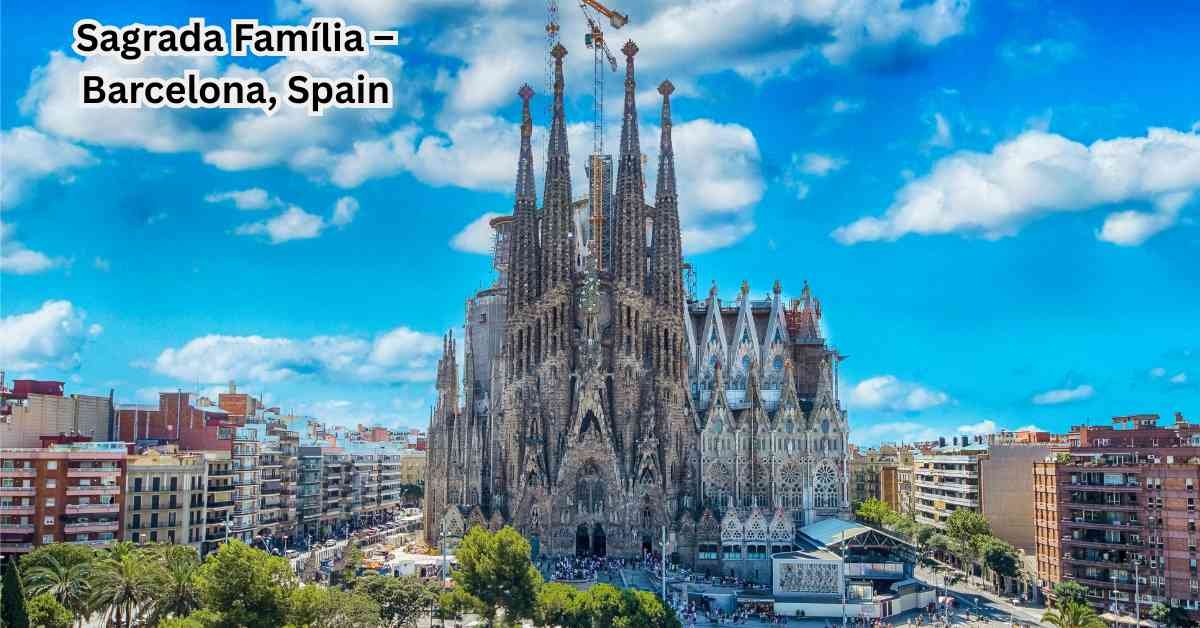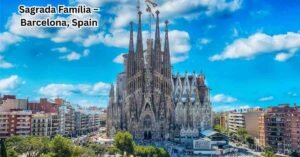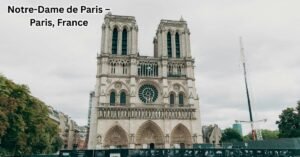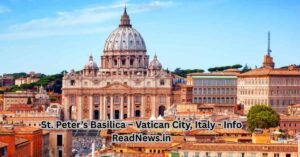A Living Masterpiece of Faith and Architecture
The Basilica de la Sagrada Família in Barcelona, Spain, is one of the most iconic and awe-inspiring churches in the world. Known for its ambitious design, intricate symbolism, and extraordinary scale, it stands not just as a place of worship but also as a work of living art. Designed by the renowned Catalan architect Antoni Gaudí, the basilica has been under construction for over 140 years, making it the longest-running architectural project in modern history — and yet, it continues to captivate millions of visitors every year.
Whether you are a pilgrim, a history lover, an architecture enthusiast, or a curious traveler, Sagrada Família offers a spiritual and visual experience unlike any other.
🛕 History & Origins
The idea of building a grand church in Barcelona dedicated to the Holy Family (Sagrada Família) was conceived in the 19th century by a local bookseller, Josep Maria Bocabella. The foundation stone was laid in 1882, and the project initially began under architect Francisco de Paula del Villar in a traditional Gothic style.
In 1883, Antoni Gaudí took over the project and completely transformed its vision. Gaudí dedicated over 40 years of his life to Sagrada Família, with the last 15 years focused entirely on the church. He famously said, “My client is not in a hurry,” referring to God.
Gaudí passed away in 1926 before the basilica was completed, but his vision continues to guide the ongoing construction to this day.
🎨 Architectural Marvel
Sagrada Família is a masterpiece of Catalan Modernism, infused with Gothic, Art Nouveau, and Organic Architecture elements. Gaudí used nature as his ultimate inspiration, making every column, curve, and window symbolic.
Key Architectural Features:
- Nativity Façade: Represents the birth of Jesus. Full of intricate sculptures, animals, and symbolic figures.
- Passion Façade: Depicts the suffering and crucifixion of Christ in a stark, dramatic style.
- Glory Façade: Still under construction, will illustrate the path to God and eternal life.
- Towers: Planned total of 18 towers — 12 for the apostles, 4 for the evangelists, 1 for the Virgin Mary, and 1 central tower for Jesus Christ. Several are already completed.
- Interior Columns: Designed to resemble trees branching out to support the ceiling, giving the impression of a forest canopy.
- Stained Glass Windows: Bathe the interior in colored light, creating a surreal, contemplative atmosphere.
🙏 Religious and Cultural Significance
Despite being under construction, Sagrada Família is an active Roman Catholic church. In 2010, Pope Benedict XVI consecrated it as a minor basilica, elevating its religious importance. Masses, especially on major holy days, are still held in designated areas of the basilica.
The basilica is also a UNESCO World Heritage Site, recognized for its outstanding cultural value and Gaudí’s creative genius.
📅 Construction Timeline and Status
Construction is funded entirely by private donations and visitor ticket sales. While the original plan was to complete it by 2026 to mark the 100th anniversary of Gaudí’s death, delays due to the COVID-19 pandemic have pushed this timeline further.
Despite the slow pace, each year sees significant progress, and once completed, Sagrada Família will be the tallest religious structure in Europe.
🧭 Visiting the Basilica
Location: Carrer de Mallorca, 401, 08013 Barcelona, Spain
Located in the Eixample district, it’s easily accessible by metro and bus.
How to Reach:
- Metro: Line 2 or Line 5 – stop at “Sagrada Família”
- Bus: Lines 19, 33, 34, 43, 44, 50, 51, B20, B24
Opening Hours:
- November–February: 9:00 AM – 6:00 PM
- March & October: 9:00 AM – 7:00 PM
- April–September: 9:00 AM – 8:00 PM
- (Closed on Christmas & New Year)
Entry Fees:
- Basic Entry: €26
- With Audioguide: €30
- With Tower Access: €36
Discounts available for students, seniors, and children under 11.
📸 What to See Inside
- Central Nave: Jaw-dropping interior with Gaudí’s signature vaulting and tree-like columns.
- Crypt: Where Gaudí is buried.
- Museum: Learn about the construction process, Gaudí’s models, and how new technology aids old design.
- Tower Views: Panoramic views of Barcelona from the Nativity or Passion towers.
🛍️ Nearby Attractions and Tips
Things to Do Around:
- Passeig de Gràcia: Upscale shopping street with Gaudí’s Casa Batlló and Casa Milà (La Pedrera).
- Park Güell: Another Gaudí masterpiece with mosaic dragons and whimsical architecture.
- Barcelona Cathedral and Gothic Quarter: Historic heart of the city.
Tips:
- Buy tickets online to avoid long queues.
- Arrive early morning or late afternoon for the best light and fewer crowds.
- Dress modestly if attending mass.
- Don’t skip the school building, built by Gaudí for workers’ children, now a museum area.
🌍 Symbolism & Legacy
Every part of Sagrada Família has a purpose, a symbol. From turtle statues at the base of columns (representing stability) to the ascending tower heights (Christ being the tallest), nothing is random. Gaudí wanted the building to “speak of the Christian faith through stone”.
Even in its unfinished state, it inspires awe. It’s a physical manifestation of devotion, patience, and divine creativity. Gaudí saw it not as a building but as a prayer in stone.
🙌 Final Thoughts
Visiting the Sagrada Família is like stepping into another world—a world where art, architecture, and spirituality merge. It’s not only a tourist attraction; it’s an ongoing legacy that continues to evolve, inspire, and touch lives.
A visit to Barcelona is incomplete without standing beneath its sky-piercing towers and feeling the light through its rainbow windows. The moment you walk in, you understand: this isn’t just a church. It’s a miracle still in the making.



